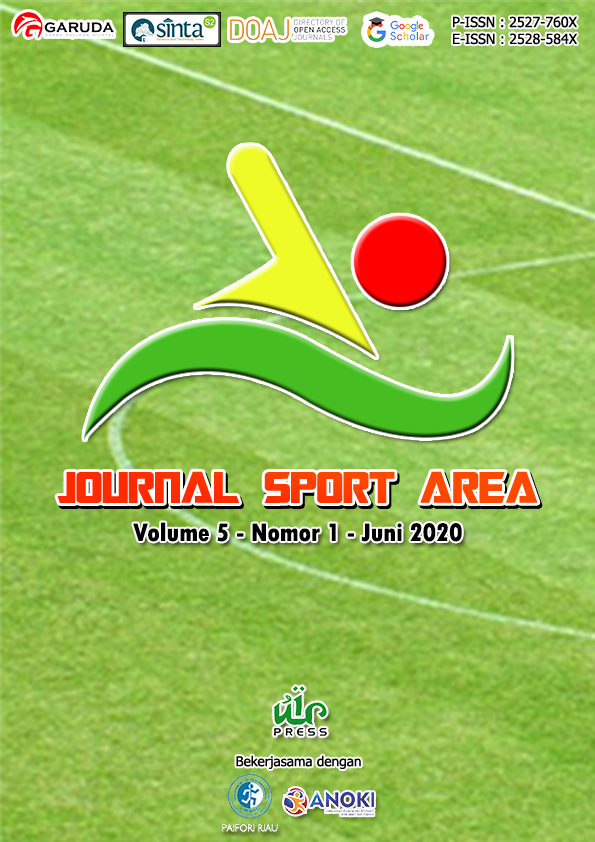E-Learning Dalam Persepsi Mahasiswa Pendidikan Jasmani
Keywords:
Perception, E-Learning, Physical EducationAbstract
This study aims to look at the perception of Physical Education students using e-learning in the learning process. Type of quantitative descriptive research. The research location was carried out in the Physical Education Study Program FKIP Universitas Islam Riau. While the sample in this study was a class of 2017/2018 students totaling 155 people, with a total sampling technique. The stages of the research were carried out in three stages, namely: (1) pre-field; (2) field work; and (3) data analysis. Data collection techniques using attitude scale questionnaire. The data analysis method used is descriptive statistics, these statistics are intended to collect data, present data and determine value. The results of the study are outlined in 4 categories: strongly agree, agree, disagree, and strongly disagree. Based on the data analysis that has been done 98% of students agree to use e-learning in learning, it can be concluded that students' perceptions about the use of e-learning as a technology-based learning media really provide convenience to improve the quality of their learning, because e-learning is easily accessed anytime without being limited space and time. In terms of the content available on e-learning as well as the usefulness of e-learning in the learning process, it is very easy for students to find information, discuss online, and upload assignments and can save student costs in printing the paper assignments given by their lecturers.
Downloads
References
Arjoyo, A. (2015). Implementasi Model E-Learning Pada Mata Pelajaran Pendidikan Agama Islam (PAI) di SMA N 6 Bengkulu Selatan. Institut Agama Islam Negeri Bengkulu.
Aziz, A. L., Al-Musadieq, M., & Susilo, H. (2013). Pengaruh Kemudahan Penggunaan Terhadap Kemanfaatan Pada Sikap Pengguna E-Learning. Jurnal Administrasi Bisnis (JAB), 6(2), 1–7.
Balaji, R. D., Al-Mahri, F. A., & Balaji, M. (2016). A Perspective Study on Content Management in E-Learning and M-Learning. Computer Science, 1–7.
Bath, D., & Bourke, J. (2010). Getting Started with Blended Learning. Mount Gravatt: Griffith University.
Chandrawati, S. R. (2010). Pemanfaatan e-learning dalam pembelajaran. Jurnal Cakrawala Kependidikan, 8(2), 172–181.
Chang, V. (2016). Review and discussion: e-learning for academia and industry. International Journal of Information Management, 36(3), 476–485. https://doi.org/https://doi.org/10.1016/j.ijinfomgt.2015.12.007
Cidral, W. A., Oliveira, T., Felice, M. Di, & Aparicio, M. (2018). E-learning success determinants: Brazilian empirical study. Computers & Education, 122, 273–290. https://doi.org/10.1016/j.compedu.2017.12.001.This
Demir, O. (2015). The investigation of e-learning readiness of students and faculty members: Hacettepe University, Faculty of Education Example. Hacettepe University.
Destriani. (2018). Minat pembelajaran menggunakan e-learning mata kuliah kinesiologi pada mahasiswa. JUMANJI, 2(1), 63–70.
Donnelly, R., & McSweeney, F. (2009). Applied E-learning and E-Teaching in Higher Education. New York: Information Science Reference.
Hernawati, E., & Aji, P. (2016). Perancangan dan penerapan konten e-learning melalui learning management system dalam meningkatkan motivasi belajar. Journal of Information Systems Engineering and Business Intelligence, 2(1), 23–32.
Karwati, E. (2014). Pengaruh pembelajaran elektronik (e-learning) terhadap mutu belajar mahasiswa. Jurnal Penelitian Komunikasi, 17(1), 41–54.
Kresnapati, P. (2018). Tantangan SDM Melalui Pengembangan Teknologi dalam Pembelajaran PENJAS di Sekolah. In Prosiding Seminar Nasional Keindonesiaan III “Penguatan SDM di Era Disrupsi Teknologi Melalui Pendidikan” (pp. 441–446). Semarang: Universitas PGRI Semarang.
Kusmana, A. (2017). E-learning dalam pembelajaran. Jurnal Ilmu Tarbiyah dan Keguruan, 14(1), 35–51.
Muzid, S., & Munir, M. (2005). Persepsi Mahasiswa Dalam Penerapan E-Learning Sebagai Aplikasi Peningkatan Kualitas Pendidikan (Studi Kasus Pada Universitas Islam Indonesia). In Seminar Nasional Aplikasi Teknologi Informasi (pp. 27–34).
Najib, H. M., Bakar, N. R. A., & Othman, N. (2017). E-pembelajaran dalam kalangan pelajar di sebuah institusi pengajian tinggi Selangor. Attarbawiy: Malaysian Online Journal of Education, 1(1), 74–82.
Saifuddin, A. (2015). Sikap Manusia Teori dan Penerapannya. Yogyakarta: Pustaka Pelajar.
Saifuddin, M. F. (2016). E-learning dalam persepsi mahasiswa. Jurnal VARIDIKA, 29(2), 102–109.
Sari, I. P. (2017). Implementasi pembelajaran berbasis e-learning menggunakan claroline. Research and Development Journal Of Education, 4(1), 75–87.
Setiawan, W., Hana, M. N., & Waslaluddin. (2014). Analisis Penerapan Sistem E-Learning FPMIPA UPI Menggunakan Technology Acceptance Model (TAM). Jurnal Pengajaran MIPA, 19(1), 128–140.
Sugiyono. (2016). Metode Penelitian Kuantitatif, Kualitatif dan R&D. Bandung: PT Alfabeta.
Published
How to Cite
Issue
Section
This is an open-access article distributed under the terms of the Creative Commons Attribution-ShareAlike 4.0 International License which permits unrestricted use, distribution, and reproduction in any medium. Copyrights of all materials published in Journal Sport Area are freely available without charge to users or / institution. Users are allowed to read, download, copy, distribute, search, or link to full-text articles in this journal without asking by giving appropriate credit, provide a link to the license, and indicate if changes were made. All of the remix, transform, or build upon the material must distribute the contributions under the same license as the original.
Accepted 2020-06-05
Published 2020-06-18












